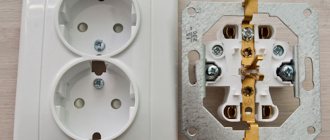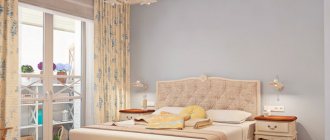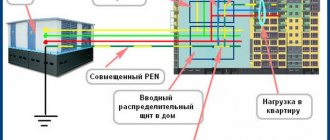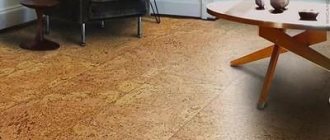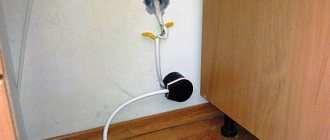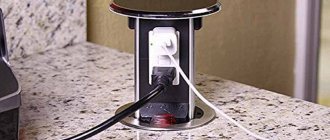Modern TV is a real multimedia station. Game consoles, audio equipment, Internet cables and many other peripherals are connected to the TV. When hanging a TV on the wall, it is very important to correctly design the supply of electrical power and low-current networks: communications must be hidden and at the same time meet safety standards. General rules for the location of TV outlets, as well as specific recommendations for each room in the apartment, are given in the article below.
Kitchen
For household appliances and interior lighting
Before installing a kitchen, it is important to plan the location of the equipment and its quantity in order to provide the necessary sockets.
Standard items: stove or hob and oven, refrigerator, hood. Optional: microwave oven, dishwasher, kettle, coffee machine, toaster, multicooker, built-in lighting. When renovating, you cannot know for sure whether you will have a toaster in a few years or not, so it is better to make a little more sockets in advance. It should be taken into account that not every time small household appliances will be used and connected to the network at the same time. The result is approximately 7-8 sockets only in the area of the kitchen unit. Add a couple more pieces near the dining table in case you need to charge your phone or want to place a table lamp there.
Photo: Instagram 9520383777marat
Recommended installation height for sockets for built-in appliances: 30-60 cm. Some place them in the furniture base - at a height of 5 cm from the floor. Sockets should not be located directly behind built-in electrical appliances. It is better to make a socket for the hood at a height of 50-60 mm from the top of the kitchen cabinet. It should not be covered by the ventilation duct.
Place the sockets above the tabletop at a height of 10-30 cm from the work surface.
Photo: Instagram sdelano.ru
For additional equipment
Sometimes sockets in the kitchen are also needed for a vacuum cleaner. In this case, they should be placed at a height of 30-40 cm from the floor.
A common kitchen switch is sometimes placed in the hallway; place it at a height of 75-90 cm and at a distance of 10-15 cm from the door.
Design: AnARCHI
The placement of outlets for the TV depends on the location where you place it and the size of the screen. It is better to hide them behind the screen, but provide access to the power plugs. You will need 2 standard electrical outlets: one TV and one Internet outlet - a mandatory option for modern smart TVs.
- Kitchen
How to place sockets in the kitchen conveniently and safely: 4 important tips
General recommendations for the location of sockets when hanging a TV on the wall
To properly make sockets for a TV on the wall, you must adhere to the following conditions. For the safe operation of devices, the basic restrictions, which are determined by the Electrical Installation Rules, must not be violated.
- The location of connectors and cable routes should not interfere with the subsequent installation of the TV receiver. It is necessary to leave space for convenient mounting of the brackets.
- Junction boxes, connectors, cables and wires must be completely hidden. A modern, thin TV pressed against the wall without hanging communications fits well into the design of the room and looks like a painting.
- For each room where a TV receiver is planned, the outlet must correspond to the functionality of the device. Later, it will be difficult to carefully install an additional cable, and extra nodes will be additional costs.
- Connections must be easily accessible so that connections can be made effortlessly. In addition, over time, connection parts wear out and become dirty. Repair and replacement of some elements may be required.
Living room
At the door
For the location of switches and sockets at the living room door, the same rules apply as in the kitchen: height 75-90 cm, free access for all family members of different heights.
Photo: kvadrim.ru
An outlet is also needed in the entrance area: for a vacuum cleaner or a heater. On average, the height from the floor should be 30 cm, from the door opening - 10 cm.
In the TV zone
A TV is a must-have item for many in the living room. The TV area needs several sockets. The average height of the location is 130 cm, then they will not be visible behind the equipment. You will need 2 electrical outlets and one outlet each for TV and Internet.
Design: Studio NW-Interior
In the sofa area
When planning outlets in the living room, you need to take into account the location of floor lamps, electrical appliances, as well as additional outlets for a laptop and telephone. The average height is from 30 cm.
Often, when planning outlets in living rooms, appliances such as air conditioners, electric fireplaces, humidifiers and game consoles are forgotten. Consider the appliances you have and those you plan to purchase, and based on this, plan the number of outlets.
At the desktop
Often the living room is also a work area. In this case, you will need more sockets. Provide 2-3 pieces in the place where the desktop will be. It’s more convenient to place them above the table so as not to have to crawl under it every time to turn it on/off, but not everyone likes this solution aesthetically. If you have a desktop computer, you can put sockets at the bottom - it is unlikely that you will constantly turn it on and off.
Design: ItalProject
Useful tips
Sockets are not only a necessary technical design, but also an attribute that can become an excellent addition to the interior. Manufacturers produce a wide range of designs with bodies of different decorative shapes and colors. There are built-in sockets, as well as products equipped with special covers that mask the hole. Thanks to such an assortment, choosing the right option is not so difficult.
Due to heavy loads, the wiring in the bedroom must be replaced during the construction phase. Otherwise, there is a possibility that if there is an overload, the entire network will fail. When installing a new cable, it is recommended to give preference to copper wires or modern material made from a mixture of aluminum and brass.
If you have no experience in performing construction work, it is better to trust the professionals. When choosing the location of electrical appliances, you can rely on domestic and European standards. Electricians prefer the latter because they combine convenience, practicality and safety.
Children's room
At the door
At the entrance to the room, a switch is traditionally placed. Typically, the toggle switch is installed at a height of 75-90 cm from the floor, so that each family member is comfortable. It is also important to ensure that the switch is not blocking a cabinet or an open door - place it on the same side as the handle.
Photo: sdelano.ru
An outlet should also be located next to the switch. You will need it for a vacuum cleaner, heater or humidifier. Recommended placement parameters: height about 30 cm and distance from the door 10 cm. If the child is small and begins to walk, provide plugs or covers for sockets.
At the berth
Near the bed you will need an outlet for a night light, a musical pendant for the crib or another device (for example, a humidifier). Don't forget about protection; this place will become the most accessible for the child as soon as he begins to stand up independently in the crib.
For an adult child, sockets are also useful opposite the bed for the TV. Sometimes they can be interestingly used in the interior if you haven’t bought a TV yet.
At the desktop
The student’s room should have a desk—sockets are also needed there. At least for a lamp and a computer. Where to place it - above the countertop or below - is a controversial issue. Some people find it inconvenient to constantly crawl under the table to connect the device. Others don't like the look of wires. Choose after weighing the pros and cons.
- Apartment
Replacing wiring in a panel house: how to do it right
Coswall CS-OFSO-3DE-SW – triple socket
Another universal model that works with a rated mains voltage of 100-240 V. The product has a rectangular shape and is equipped with 3 sockets. The socket is ideal for installation in an office or next to a desktop computer.
The design has rather large dimensions - 222x118x65 mm. And the thickness of the front model is only 2.5 mm, so the structure will not stick out from the wall. In reviews, users praise the good opening mechanism. If in most similar sockets the socket “flies out” instantly after pressing the button, then in the case of CS-OFSO-3DE-SW it slides out smoothly, which means it will last longer without breaking.
Pros:
- 3 connectors;
- silver cover;
- smooth opening;
- metal case;
Minuses:
- no USB port provided;
- weight.
VIEW ON ALIEXPRESS
Bedroom
Next to the bed
A modern person needs an outlet near the bed. Charge your phone, e-book, work on your laptop - it will be inconvenient without an outlet nearby. A block of several sockets on the sides of the bed will save you from these inconveniences.
Photo: Instagram switchtowood
At functional areas
Further options depend on the furniture and areas that are provided in the bedroom. If this is a desktop, the rules will be the same as for the living room and children's room. If you want to hang a TV, also consider the recommendations listed above.
Design: Olga Shipkova
At the door
Here you need to place a switch - the average height is the same as in other rooms. There may be several switches, depending on the lighting plan of the room: spots, floor lamps, sconces. It would also be a good idea to provide an outlet for a vacuum cleaner.
What determines the number of sockets?
To talk about a sufficient number of food outlets, it is necessary to understand the size of the room, its zoning, and the location of large furniture and equipment.
Bedroom size
The large area of the room provokes the owners to rearrange. And if moving furniture is not a big problem, then changing the wiring diagram is labor-intensive and expensive. Therefore, it is better not to skimp and make a reserve for the future: place a block of two sockets in all corners of the room.
Even where there will be a wardrobe or bed. It costs almost nothing on the scale of the entire renovation, but you will thank yourself in the future.
Experts advise placing a block of two sockets in each corner of the bedroom
Room zoning
Each area of the room has its own requirements for electrical sources. It is advisable to clearly determine the initial location of the bed, desk, TV, and closet.
It is worthwhile to think about the placement of electrical appliances and equipment in advance at the repair stage.
Bathroom
The number of sockets depends on the electrical appliances that you will place in the bathroom. Standard: washing machine, hair dryer; optional: water heater and electric heated towel rail. It is important that the distance from the outlet to the floor and water source is at least 60 cm.
Photo: Instagram sdelano.ru
For the bathroom, special waterproof versions of sockets with a cover and a special degree of protection are needed. They are protected on the inside and allow water to drain if it gets inside the outlet.
- Security and home automation
How to choose and install sockets and switches in wet rooms
Availability of grounding
Household appliances that consume large amounts of power must be grounded, which will provide reliable protection against electric shock. This mainly applies to washing machines, electric stoves, boilers, etc.
In the usual version, the socket has only two contacts - phase and zero. The grounded socket has one more contact - it performs this function.
On sockets that are installed in children's rooms, there are so-called curtains as additional protection; they prevent foreign objects (nails or pins) from getting into the socket contacts.
Sequence of DIY work
Let's look at how to install a TV outlet yourself.
When is gating necessary?
Grooves are used on monolithic and brick walls with large surfaces. This is true for external load-bearing coverings and partitions without the presence of power cords in them. The thickness of the drilling is large, such walls cannot be damaged. To groove internal planes, you will need permission from the construction department.
Installation options without grooves
This open installation involves installing sockets on an external wall without drilling channels and holes for socket boxes. The wires will run outside along the plane.
Also, the optimal solution is to install surface-mounted electrical installations. This option is great when the renovation has already been done and you don’t want to spoil the finish. The connector can even be installed on top of tiles.
Selecting wire cross-section
The indicator is measured in square millimeters and shows throughput. To ensure safe operation of the receiver, purchase a cable with a reserve cross-section, then the insulation will not be damaged by the load.
The wire cross-section is not equal to the diameter. The latter is measured with a ruler, put into a formula and the cross-sectional area is calculated.
The wiring cable is always rounded up. For example: when calculating it turned out to be 2.2 square meters. mm. This means that you need to take a 2.5 square cable.
Fastening and fixing
There are 2 options for connecting the connector. The star pattern means that the old wiring is removed and the new wiring is placed through the splitter. It is designed to branch a signal, divide it into packets and amplify it.
Electrical sources are placed at the entrance of the wire into the living space from the entrance. Then the antenna conductors are wired. Used frequently. Advantages:
- the wires are located in a technically safe place, which is important during installation and routine inspection;
- the signal is stable;
- The separated packages continuously supply current to the TV sockets.
The second installation method is daisy chain. The main cable extends to any TV, and then branches into 2 or more parts to other devices directly at the connector. With this connection scheme, there is a saving on cables. The disadvantage is that the quality on the first TV will be higher than on subsequent ones.
How much wire is needed
Now there are different methods of data transmission that require their own connection to the network. Instead of 1 socket, install a block that contains at least 4 connectors.
Connecting digital television (IPTV)
In addition to connecting to analogue television, many television providers now have the opportunity to connect to digital television. The quality there is much higher. Digital television connection diagram - star only.
The fundamental differences are that a digital (computer) cable is used, a star connection; instead of a splitter, a digital splitter (router or hub) is used, which has one input and several outputs. One TV is connected to one output. The TV must understand the digital IPTV signal - have a CAM module. If your TV does not receive a digital TV signal, you need a special SD set-top box. In both cases, a smart card is purchased from the provider for charging and managing services.
Ask your provider if digital television (DVB) is the future. In apartment buildings in large cities, analog television will last a couple more years.
And the ethereal antennas have already died. Remember, 5-10 years ago all the windows, balconies and roofs of apartment buildings were covered with antennas?
Mount selection
Your next step will be to select a mount or bracket that will hold the TV on the wall. In general, for each specific brand and model there is, or at least recommended by the manufacturer, a separate type of fastening. All of them are standardized, but the most popular is the category with the abbreviation VESA.
All fasteners come in several types:
Rigid fasteners are a cantilever system, the elements of which will always be in the same strictly fixed position. The inclined and rotary types imply a movable system, that is, a bracket. Let's look at each type of fastening in more detail.
Location of lighting points
Lighting control points in the house are divided into three main groups:
- This includes classic switches - these are devices of different types, often with one or two keys. But thanks to three-key switches, you can simultaneously use three different groups of lighting installations.
- This group includes switches, which, when activated, control several lighting sources from different places at once.
- This group includes devices in which lighting control mechanisms are already built into the lighting tools. These include a table lamp and a floor lamp/
In the apartment, almost all rooms are equipped with one- or two-key switches, which is considered justified and, most importantly, comfortable.
The category of general lighting often includes lamps placed under the ceiling, providing uniform diffused light
For example, for a bathroom, an additional light source can be a lamp above the mirror. But regulation for such a device is carried out using a built-in switch
The bedroom has its own unique switch system. It allows you to adjust the light source simultaneously from different places. Let's look at convenience using an example.
Each sleeping place must be equipped with a lamp in the form of a night light on a table, bedside table, wall sconce or floor lampEvery time you need to turn the light on or off, you have to get out of bed, since the switches are located quite far from the bed. The solution is obvious. Three switches are installed in the room at once. One is at the exit from the room, and the other two are on both sides of the bed. As a result, it has become very easy to regulate the lighting in the bedroom, and access to switches will be at hand.
In cable channel
A special box also allows you to hide the wires. However, this is a less aesthetic option. The user can make a cable channel independently or buy a ready-made one in a store. Hiding wiring in a box is much easier and faster than making special holes in the floor.
Having carefully studied the assortment of special stores, we come to the conclusion that users are offered several types of cable channels. The simplest option is PVC boxes. Absolutely everyone saw them. This is an ordinary cable channel made of plastic. Most often they are found white. The removable cover is held in place by latches.
